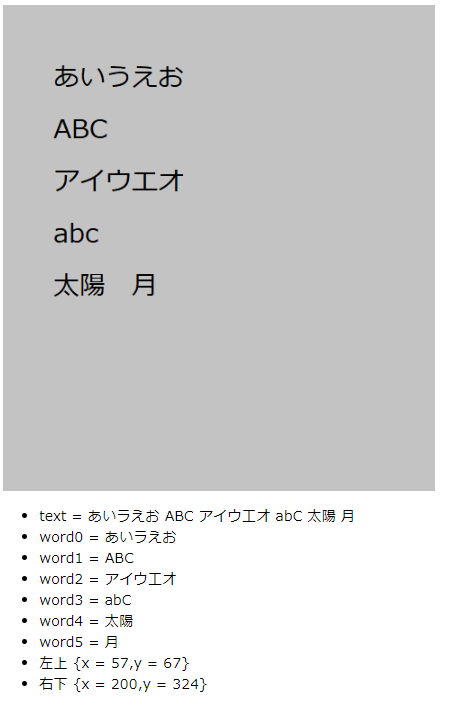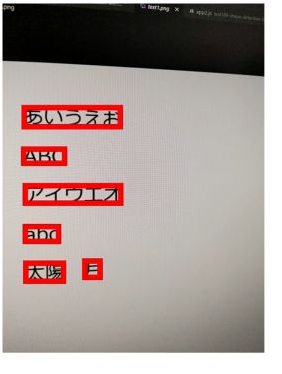冒頭からタイトル詐欺であることを読者には謝罪したい。
Shape Detection API を使用して、テキストの読み取りは動作確認ができなかった。
代わりにtesseract.jsを使用して、テキストの読み取りを試みたので、そちらをレポートします。
目次
参考
実装 1(画像の中の文字を読み取る)
test1.html1
2
3
4
5
6
7
8
9
10
11
12
13
14
15
16
| <html>
<head>
<script
src="https://code.jquery.com/jquery-3.5.1.slim.min.js"
integrity="sha256-4+XzXVhsDmqanXGHaHvgh1gMQKX40OUvDEBTu8JcmNs="
crossorigin="anonymous"
></script>
<script src="https://cdn.rawgit.com/naptha/tesseract.js/1.0.10/dist/tesseract.js"></script>
</head>
<body>
<img src="text1.png" id="source" />
<div id="result"></div>
<script type="text/javascript" src="app1.js"></script>
</body>
</html>
|
app1.js1
2
3
4
5
6
7
8
9
10
11
12
13
14
15
16
17
18
19
20
21
22
23
24
25
26
27
28
29
30
31
32
33
34
| const image = document.getElementById("source");
let texts = null;
if (!("TextDetector" in window)) {
alert("TextDetector is not available");
}
window.onload = async () => {
const result = await Tesseract.recognize(
image,
{ lang: "jpn" },
{ logger: (m) => console.log(m) }
);
console.log(result);
let resultText = "";
for (const block of result.blocks) {
let resultWord = "";
block.words.forEach((word, i) => {
resultWord += `<li>word${i} = ${word.text}</li>`;
});
resultText += `
<ul>
<li>text = ${block.text}</li>
${resultWord}
<li>左上 {x = ${block.bbox.x0},y = ${block.bbox.y0}}</li>
<li>右下 {x = ${block.bbox.x1},y = ${block.bbox.y1}}</li>
</ul>
`;
}
$("#result").html(resultText);
};
|
recognizeの第二引数には言語の指定を行います。
指定できる言語は、tessdocに紹介されています。
こちらを動かすと、次のようになります。

ひらがなの「う」をカタカナの「ラ」と誤判定しているようです。
たしかに似ているといえば、似ています。
tesseract.jsの判定結果のオブジェクトは、単語単位、行単位、さらに大きな塊の単位など階層構造になっています。
今回は抜粋し、大きな単位での、文字列全体。
単語単位での表示。そして全体の左上と右下座標を表示してみました。
実装 2 カメラから読み込む
前回同様に、カメラから取り込みし文字の認識を試みます。
test2.html1
2
3
4
5
6
7
8
9
10
11
12
13
14
15
16
17
| <html>
<head>
<script
src="https://code.jquery.com/jquery-3.5.1.slim.min.js"
integrity="sha256-4+XzXVhsDmqanXGHaHvgh1gMQKX40OUvDEBTu8JcmNs="
crossorigin="anonymous"
></script>
<script src="https://cdn.rawgit.com/naptha/tesseract.js/1.0.10/dist/tesseract.js"></script>
</head>
<body>
<div id="canvas_area">
<canvas id="result" width="900" height="900"></canvas>
</div>
<div id="result_text"></div>
<script type="text/javascript" src="app2.js"></script>
</body>
</html>
|
1
2
3
4
5
6
7
8
9
10
11
12
13
14
15
16
17
18
19
20
21
22
23
24
25
26
27
28
29
30
31
32
33
34
35
36
37
38
39
40
41
42
43
44
45
46
47
48
49
50
51
52
53
54
55
56
57
58
59
60
61
62
63
64
65
66
67
68
69
70
71
72
73
74
75
76
77
78
79
80
81
82
83
84
85
86
87
88
89
90
91
92
93
94
95
96
97
98
99
100
101
102
103
104
105
106
107
108
109
110
111
112
113
114
115
116
|
const image = document.createElement("video");
const offscreen_canvas = document.createElement("canvas");
const offscreen_context = offscreen_canvas.getContext("2d");
const canvas = document.querySelector("#result");
const context = canvas.getContext("2d");
offscreen_canvas.width = canvas.width;
image.videoWidth = canvas.width;
offscreen_canvas.height = canvas.height;
image.videoHeight = canvas.height;
let texts = null;
window.onload = async () => {
console.log("onload");
const stream = await navigator.mediaDevices.getUserMedia({
video: {
facingMode: { exact: "environment" },
},
});
image.srcObject = stream;
image.play();
analysis();
setInterval(() => {
reflesh();
}, 800);
};
const analysis = async () => {
offscreen_context.drawImage(image, 0, 0);
try {
texts = await Tesseract.recognize(offscreen_context, {
lang: "jpn",
}).progress(function (p) {
console.log(p);
});
} catch (e) {
console.log(e);
window.requestAnimationFrame(analysis);
return;
}
console.log(texts);
let state = true;
if (texts == null) {
state = false;
}
if (state == true && texts.text.length == 0) {
state = false;
}
if (state) {
offscreen_context.strokeStyle = "rgb(255, 0, 0) ";
offscreen_context.lineWidth = 10;
texts.blocks.forEach((block) => {
block.words.forEach((word) => {
offscreen_context.beginPath(word.bbox.x0, word.bbox.y0);
offscreen_context.lineTo(word.bbox.x1, word.bbox.y0);
offscreen_context.lineTo(word.bbox.x1, word.bbox.y1);
offscreen_context.lineTo(word.bbox.x0, word.bbox.y1);
offscreen_context.lineTo(word.bbox.x0, word.bbox.y0);
offscreen_context.closePath();
offscreen_context.stroke();
});
});
}
context.drawImage(offscreen_canvas, 0, 0, canvas.width, canvas.height);
window.requestAnimationFrame(analysis);
};
const reflesh = () => {
$("#result_text").empty();
if (texts == null) {
$("#result_text").text("ERROR");
return;
}
if (texts.text.length == 0) {
$("#result_text").text("ERROR");
return;
}
let resultText = "";
texts.blocks.forEach((block) => {
console.log(block);
resultText += `
<ul>
<li>text = ${block.text}</li>
</ul>
`;
});
$("#result_text").html(resultText);
};
|
コメントでも記載していますが、recognizeの第一引数に video オブジェクトのimageを与えると動作が非常に不安定になりました。
動作させたときのは以下のようになります。

うまくいかないときは、文字のないところを誤検知もします。
カメラの入力を基に、画像上の文字の取得、位置の取得ができました。
今回は、Shape Detection API での文字認識がかなわず、tesseract.jsでの、文字認識を試みました。
recognizeの第一引数に最初はimageを渡していたわけですが、この場合の動作が不安定でした。
この点にはまって数時間かけてしまいました。
文字の認識処理は、バーコードと異なり数秒から十数秒かかるものでした。
結果としてバーコード読み取りの速さを再認識することになりました。
今回は日本語で検知を行ったことも処理が遅くなった要因の 1 つであるます。
Shape Detection API の記事 3 部作、これにて終了です。
実戦レベルなのは、バーコード読み取りだけかなーというのが一通り(最後のは動作確認できませんでしたが)触った所感でした。
ではでは。

